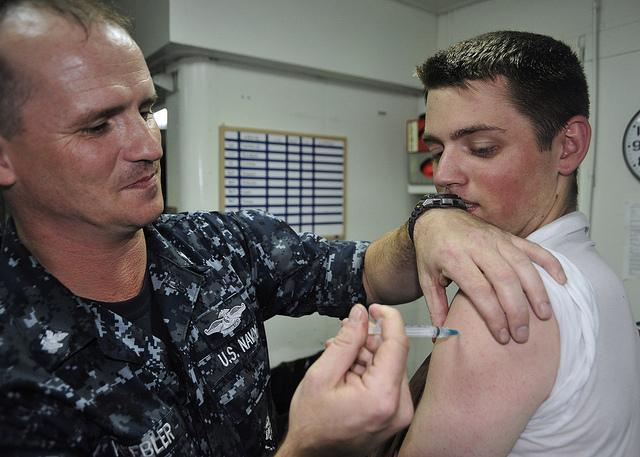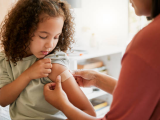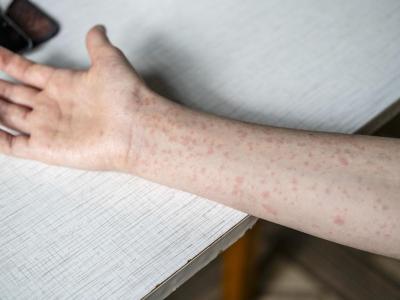As expected, a Food and Drug Administration (FDA) advisory committee today endorsed the World Health Organization's (WHO's) choice of influenza strains for the 2015-16 seasonal flu vaccine, but not without considerable discussion.
In addition, the committee heard preliminary estimates suggesting that this year's flu vaccine may have been considerably more effective in the dependents of US military personnel than it has been in the US population as a whole. The meeting was streamed over the Web.
Two of three strains to change
On Feb 26 the WHO recommended changing two of the three strains in trivalent flu vaccines for the next Northern Hemisphere flu season: H3N2 and influenza B. The chosen strains—an A/Switzerland-like virus for H3N2, a B/Phuket-like strain for type B, and an A/California-like strain for H1N1—are the same ones chosen for this year's Southern Hemisphere flu season.
Today the FDA's Vaccines and Related Biological Products Advisory Committee (VRBPAC) unanimously approved the WHO's selections for the H3N2 and H1N1 strain. On the type B virus (B/Phuket), the vote was 15-1 in favor.
A change in the H3N2 vaccine strain had been expected, since most of the circulating H3N2 viruses in the United States and a number of other countries have not matched well with the vaccine. Because H3N2 has been the vastly predominant flu type this year, this mismatch has been blamed for low vaccine effectiveness. This week the US Centers for Disease Control and Prevention (CDC) estimated overall flu vaccine effectiveness (VE) in the United States this season at 19%.
In picking the Phuket strain for type B, the WHO said B/Yamagata lineage viruses have been the predominant type B lineage this season, outnumbering Victoria lineage viruses. The agency said serum samples from ferrets vaccinated against the B/Phuket strain ably inhibited recently circulating Yamagata lineage viruses. In contrast, serum from humans who received this year's vaccine, containing a B/Massachusetts strain, did not react as strongly to the circulating Yamagata viruses.
The dissenting vote on the type B virus for trivalent vaccines was cast by Michael Hudgens, PhD, of the University of North Carolina at Chapel Hill. In the discussion before the vote, he said data presented earlier by Jacqueline Katz, PhD, of the CDC showed that 94% of the Yamagata viruses circulating in the United States were of the Massachusetts strain, yet "we're about to switch to something else."
Among other comments in reply, Katz said, "In the antigenic cartography the viruses circulating globally were really clustered in the group represented by B/Phuket, and the difference from the Massachusetts virus was quite distinct."
VRBPAC member Janet Englund, MD, added, "It's incredibly important to see what's going on in Asia and the Southern Hemisphere; we know it drifts westward and northward. A really high proportion of those viruses come to us next."
In other discussion, member Roland Levandowski, MD, commented that among type B viruses, Yamagata has been dominant for 4 years in a row. That might suggest that Victoria viruses may make a comeback soon, since population immunity to Yamagata viruses is probably building, he said.
Katz responded, "Dr. Levandowski has a good point. We may be due for a B/Victoria season, but it's very hard to predict."
Some flu vaccines now are quadrivalent, containing four flu strains, including two type B viruses to cover the Yamagata and Victoria lineages. The WHO recommended that quadrivalent vaccines for the next season include a B/Brisbane/60-2008-like (Victoria) virus—the same Victoria strain in this season's quadrivalent vaccine—and VRBPAC unanimously approved that recommendation today.
Military vaccine effectiveness findings
In other developments at the meeting, Michael Cooper, PhD, presented estimates of this season's flu VE in US military personnel and their dependents. He is a captain in the US Public Health Service and leader of Respiratory Pillar Activities, Division of Global Emerging infection Surveillance, Armed Forces Health Surveillance Center.
He presented preliminary findings from three studies, two of them focusing on dependents of military personnel and the other on service members themselves. The two studies on military dependents used the test-negative case control method, in which people seeking care for flu-like illnesses are tested for flu and their vaccination status is determined.
One study involved 468 flu-positive cases and 694 controls, with respective vaccination rates of 29% and 27%, Cooper reported. For those who received inactivated flu vaccines, the VE was estimated at 40% overall and at 48% in children, he said. The number for children was statistically significant.
In the second analysis, also involving military dependents, most of them younger than 18, there were 140 flu cases and 278 controls, with vaccination rates of 17% and 31%, respectively, he said.
The overall VE was 53%, and VE against H3N2 viruses was 47%, he reported.
The third study, focusing on active-duty military members, used as controls individuals who sought medical care for something other than a flu-like illness. The study included 2,045 case-patients, 89% of whom were vaccinated, and 8,015 controls, 88% of them vaccinated.
The adjusted VE for those who received inactivated vaccine was -4%, which was not significant, Cooper reported. For those who received the live attenuated (nasal spray, or LAIV) flu vaccine, the VE was estimated at -32%, which was statically significant, he said.
Regarding the nasal-spray vaccine estimate, he commented, "We believe that this is likely due to unmeasured confounders, or possibly chance. We don't believe that LAIV increases risk of influenza infection."
In mid-January the CDC estimated that the VE for LAIV against H3N2 viruses was -23%, while the VE for inactivated vaccines against H3N2 was a nonsignificant 15%.
See also:
Mar 4 VRBPAC meeting agenda
Feb 26 WHO recommendation on strains for 2015-16 vaccine
Related Feb 26 CIDRAP News story on nasal-spray vaccine




















